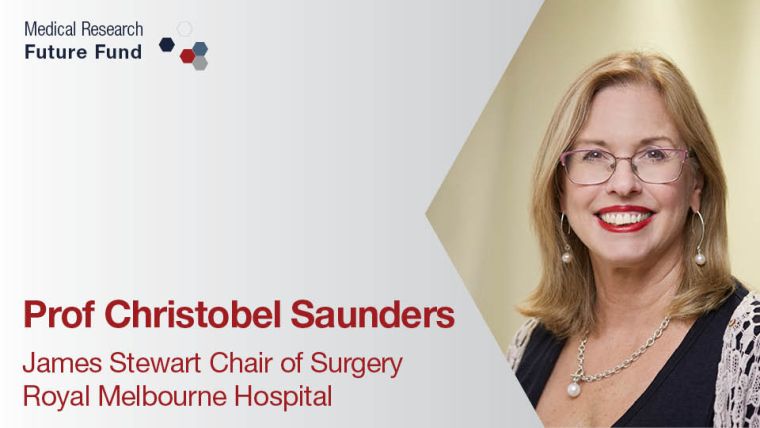
Hitting the right spot
For the one in seven Australian women who are diagnosed with breast cancer, the first line of treatment is surgery. Surgeons aim to take out all the cancer, so it doesn’t grow back. To do this, surgeons use their sense of touch to find the edges of the cancer which feel stiffer than normal tissue.
But surgeons don’t know for sure if they’ve removed all the cancer until after the operation. They must send the excised tissue to a pathology lab to be examined under a microscope. The lab checks if the margins of normal tissue around the excised cancer are wide enough. If not, some cancer cells may have been left behind.
In breast-conserving surgery around 30% of women must have repeat surgery to take out the rest of the cancer.
‘The reality is it’s often difficult at the time of surgery to know you’ve hit the right spot,’ breast surgeon Christobel Saunders explains.
To improve this result, Christobel has spent 20 years searching for new technology to help surgeons get all the cancer out the first time.
Supercharging the surgeon’s sense of touch
Now Christobel has found a way to visualise what surgeons feel through touch.
When her research team projects light waves into the tissue area, the stiffer cancer tissue reflects the light differently to normal tissue. Quantitative Micro-Elastography (QME) uses this contrast to show the cancer cells at a microscopic scale.
Using this technique, the research team created an automated QME reader which identifies cancer cells with almost 100% accuracy.
‘That was the great exciting moment,’ Christobel recalls.
‘We realised we could differentiate cancer tissues from normal tissues with high accuracy.’
Translating benchtop research into a real time surgical probe
To turn their QME technology into a real time surgical probe the team established a start-up company.
OncoRes Medical is now developing a QME probe that allows surgeons to see in real time if they have removed all the cancer. This probe could dramatically improve the surgeon’s ability to get all the cancer out during the first operation, reducing the need to re-operate.
Reducing repeat surgery could significantly improve outcomes for Australian women who get breast cancer. The team also hopes to improve outcomes in other kinds of cancer surgery.
A suite of products for different kinds of cancer surgery
The QME probe is wired by fibre optic cable to a desktop console. It will fit in traditional operating theatres where surgeons operate directly with their hands.
But keyhole and robotic surgery are enhancing traditional surgery in new and exciting ways. These minimally invasive techniques give patients better results.
Surgeons using these techniques must find and remove the cancer without the benefit of their sense of touch.
Restoring the surgeon’s sense of touch to keyhole surgery
OncoRes Medical is developing another suite of probes suited to keyhole surgery to restore the surgeon’s sense of touch. This project is supported by $1 million from the MRFF funded BioMedTech Horizons program.
Stereoscopic optical palpation (SOP) applies stress to the tissue surface. It uses small digital cameras to map how the tissue reacts to this stress. Stiffer cancer tissue moves differently when compressed compared to normal tissue. The camera images display this mechanical contrast, or stiffness.
Compared to the QME probe, SOP is cheaper, smaller, wireless, and suited to keyhole and robotic surgery.
Sustaining Australian companies on the long road from research to product
‘We’ve got a few years to go yet before we get these technologies into practice,’ Christobel judges.
It can take years to bring a product from research to market. Sustaining a start-up company through this long road can be tough.
OncoRes CEO Kath Giles says the company’s current strategic focus is getting the QME probe to market.
But ‘surgery is constantly evolving in the quest for better outcomes. To be a sustainable Australian-based business it’s important to have a pipeline of products in development.
Having the SOP product line underway is future proofing our company.’







